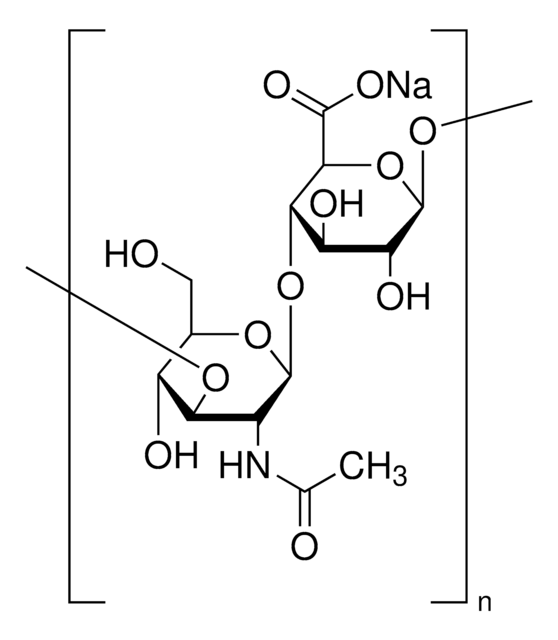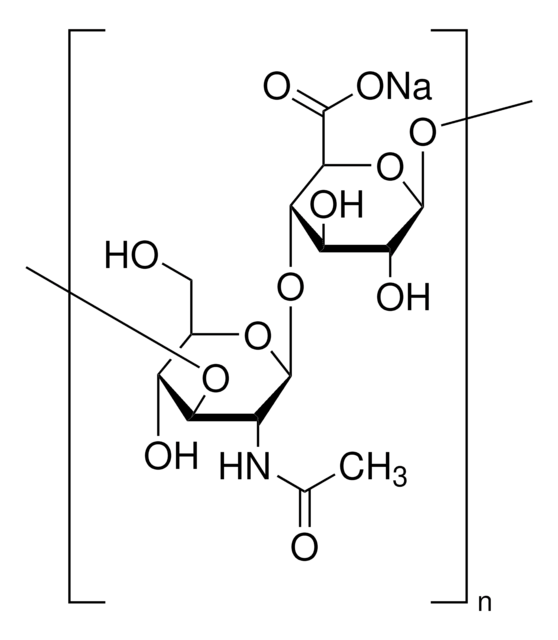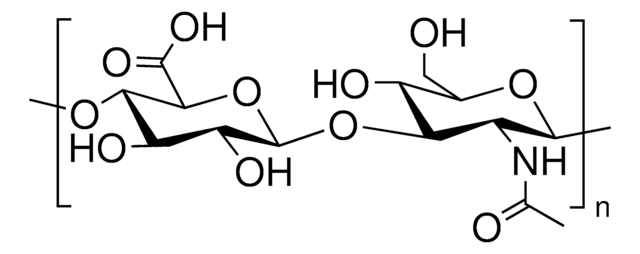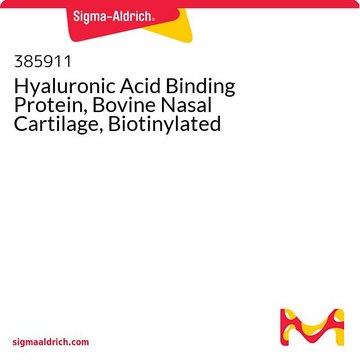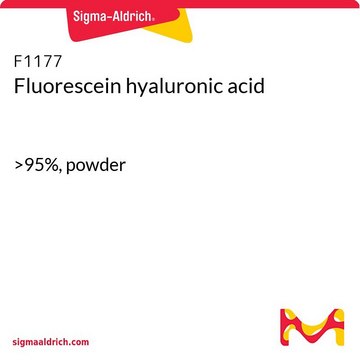B1557
Hyaluronan biotin sodium salt
≥97%, soluble powder
Synonym(s):
Hyaluronic acid biotin
Sign Into View Organizational & Contract Pricing
All Photos(1)
About This Item
Recommended Products
Quality Level
Assay
≥97%
form
soluble powder
mol wt
≥700 kDa
loss
≤5% loss on drying
color
white to tan
storage temp.
2-8°C
Application
Highly sensitive probe for detecting nanogram levels of hyaluronan binding proteins (hyaladherins).
Hyaluronan biotin (HA-biotin) may be used as a specific bioaffinity probe to detect HA-binding proteins (hyaladherins), HA-receptors and HA-binding components in tissues and cells. Hyaluronan biotin may be used in the development of affinity binding systems for the immobilization and purification of hyaladherins. HA-biotin may be used in hydrogel development and for drug targeting.
Other Notes
From cocks comb or fermentation.
Storage Class Code
11 - Combustible Solids
WGK
WGK 3
Flash Point(F)
Not applicable
Flash Point(C)
Not applicable
Personal Protective Equipment
dust mask type N95 (US), Eyeshields, Gloves
Choose from one of the most recent versions:
Already Own This Product?
Find documentation for the products that you have recently purchased in the Document Library.
P Auvinen et al.
The American journal of pathology, 156(2), 529-536 (2000-02-10)
Hyaluronan (HA) is an extracellular matrix polysaccharide that promotes cell migration through its cell surface receptors and by effecting changes in the physical environment. HA expression is frequently increased in malignant tumors, whereas its association with the invasive potential and
T Pouyani et al.
Bioconjugate chemistry, 5(4), 370-372 (1994-07-01)
Hyaluronic acid (HA) is a linear polysaccharide composed of repeating disaccharide units of D-glucuronic acid (GlcUA) and N-acetyl-D-glucosamine (GlcNAc). Hyaluronate plays an important role in many biological processes as mediated by its interactions with a number of HA-binding proteins (the
D Liu et al.
Frontiers in bioscience : a journal and virtual library, 3, d631-d636 (1998-06-23)
CD44 is a cell surface glycoprotein present on many cell types. Many CD44 isoforms have been identified. All CD44 isoforms utilize identical transmembrane and cytoplasmic domains. The hematopoietic form of CD44 (CD44H) is the major CD44 protein present on normal
Keiko Hasegawa et al.
The Journal of investigative dermatology, 127(7), 1657-1663 (2007-03-17)
Versican interacts with hyaluronan (HA) at its N-terminus and with fibrillin-1 at its C terminus. As versican in the dermis connects microfibrils to the HA-rich matrix for viscoelasticity, dermal diseases may involve destruction of these complexes. A recombinant versican protein
Yuan Cui et al.
Applied biochemistry and biotechnology, 169(1), 239-249 (2012-11-28)
Hyaluronic acid is a naturally ionic polysaccharide with cancer cell selectivity. It is an ideal candidate material for delivery of anticancer agents. In this study, hyaluronic acid (HA) micro-hydrogel loaded with anticancer drugs was prepared by the biotin-avidin system approach.
Articles
Glycosaminoglycans are large linear polysaccharides constructed of repeating disaccharide units.
Our team of scientists has experience in all areas of research including Life Science, Material Science, Chemical Synthesis, Chromatography, Analytical and many others.
Contact Technical Service
